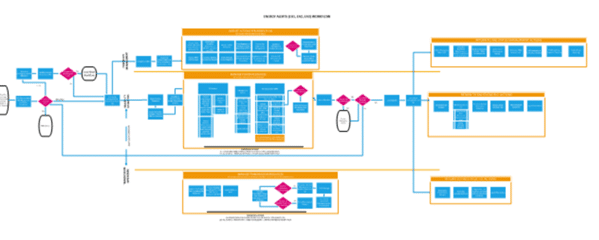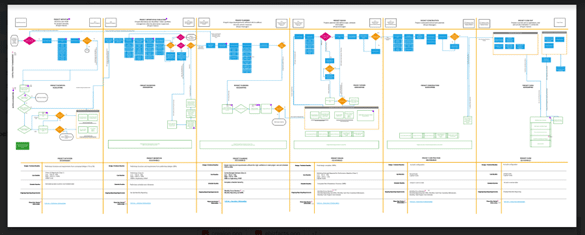
Post-Merger Process Integration
POST-MERGER PROCESS INTEGRATION
Mergers and acquisitions present several challenges for companies engaged in these undertakings. One of the biggest is process integration, which joins the policies, standards, and work procedures of two companies with different business cultures.
Savvy businesses implement a post-merger process integration plan to make the transition much easier and less complicated. It starts with plan development and works into checklists for integrating your procedures. Then, you’ll move into workflow mapping, process gap analysis, and documentation.
Finally, when your new procedures are in place, you can execute your change management program, including training and monitoring.
While all this may sound complicated, you can break this strategy into three phases:
Phase I: Integration Plan Development
- Integration plan mapping
- Checklist of integration activities/tasks
- Integration process documentation
Phase II: Process Integration
- Workflow process mapping
- Process gap analysis
- Integrated process documentation
Phase III: Process Implementation and Training
- Change management
- Training
- Monitoring
This article details post-merger process integration and how to avoid common pitfalls during mergers or acquisitions. You’ll also receive step-by-step instructions for all three phases of the plan and best practices for integrating workflows between your two companies.
Post-Merger Process Integration: A Primer
Processes are standards or operational procedures your organization uses every day. Post-merger process integration means blending the workflows of two or more companies upon completion of a merger or acquisition. It’s part of the larger post-merger integration strategy that deals with operations.
While merging procedures between two companies may sound straightforward, success requires careful planning. You’re attempting to combine separate sets of workflows from different companies having unique ways of doing things.
Change management strategies can be challenging enough without introducing a new set of policies, standards, or work tasks. Employees tend to resist change, and it can be difficult to get them on board. Having a plan for process integration can make things go much smoother.
Like any process improvement strategy, procedural integration planning helps define goals and identifies roles within each task. It streamlines the overall process and sets timelines for project completion.
Without a plan for integration, your merger can take much longer than it should. By providing a framework for the efficient use of time, personnel, and resources, you’ll complete the merger process within a reasonable timeframe.
Within your process integration plan are three primary phases:
- Integration Plan Development
- Process Integration
- Implementation and Training
Phase I: Integration Plan Development
Before process integration can occur, it’s vital to map the integration process and compile a checklist of tasks to complete. The development phase also includes providing detailed instructions for each activity associated with post-merger process integration.
Integration Plan Mapping
Your planning map provides a visual representation of the tasks you need to perform during post-merger integration. It identifies the roles and responsibilities of each department and provides a timeline to complete each task.

Post-merger integration often takes up to 12 months and beyond. Mapping your process integration plan ensures you don’t have to spend more time than necessary. It offers an efficient strategy for staying on track and provides more detail and clarity than merely listing individual tasks on a page.
Task Checklist
This lists the tasks associated with integrating the documents from the merging company into your existing organization. Examples include:
- Initial steps, including setting key objectives, planning, and appointing teams
- Setting timelines for each task
- Gap analysis
- Documentation strategies
- Documentation management and training
All departments are affected by the merger. For this reason, each must do its part to facilitate the completion of all tasks on the checklist.
Process Planning Documentation
Once you have the integration diagram and all the tasks are listed, it’s time to provide detailed policies, standards, and procedures concerning integration. For example:
Policy Document
- Provide general information concerning the merger, including overall goals and objectives
- Define the integration process and why it’s important
- Give general timelines for completing the integration
- List broad expectations of all stakeholders during the process
Integration Standards
- Provide general guidelines for integration
- Break down each task and assign them to departments
- Give a specific timeline for the completion of each task
Work Instructions
- Provide step-by-step guidance for completing each task in the integration process
- Offer simple language and easy reference
- Specify delivery method, including print, web, app, or video
Phase II: Process Integration
The planning phase is over. Now it’s time to combine the workflows and procedural documents of both companies. First, map all workflows and perform a gap analysis.
Workflow Process Mapping
Workflow processes are the standards and instructions you give those performing daily operations within your organization. A workflow process map is similar to the map you created for your integration plan, except:
- It’s much more extensive since it covers every procedure for the entire company.
- It provides details of every facet of your operation.
- It involves every department.

Make a comparison between your current procedures and the ones from the merging company. Decide which processes complement each other and which ones to discard or revise.
Process Gap Analysis
Combining procedures can create potential problems, redundancy being the biggest one. Overlapping processes between the two companies result in duplication and inefficiencies.
Also, you may need additional procedures to handle increased personnel, equipment, and facilities. Gap analysis identifies these problems by measuring results against defined goals. It takes into account any gaps or inefficiencies created by insufficient procedural documentation.
While gap analysis typically works well for established brands, challenges could arise for newly merged organizations. For example, knowing how process integration will affect systems, employee morale, or costs is impossible.
Instead of being able to discern current problems, you’ll have to rely on creating future scenarios. But once you have all the possible gaps listed, you can begin writing your process documentation.
Integrated Process Documentation
Use the same strategy for your organizational process documentation as you did during the planning stage. Except in this case, your policies, standards, and tasks will cover your entire organization. They will also be much more detailed and pertain to all departments.
You’ll be breaking down your documentation into three types:
- Policies. Your company’s overall mission objectives, core cultural statement, and expectations of employees and key stakeholders. While technically not procedures, policies provide a broad view of how your company will handle the merger going forward.
- Standards. Outlines of tasks that assign the departments or people to perform them. Provide the tools to carry out your policies.
- Procedures. Step-by-step instructions for completing individual tasks. These are the most granular work instructions and can be found in all verticals of your organization.
Phase III: Process Implementation and Training
After writing and integrating new policies, standards, and procedures into your organization, you must have a system for implementing them. Providing employee training for each task is essential, ensuring a smooth transition.
Change Management
Even though you’ve completed the hard work of integrating the merged company’s procedures into your own, there’s still much work ahead. You must get all stakeholders—namely, employees—on board with the changes. But this is easier said than done.
A new procedure rollout strategy can help convince employees that the changes will benefit everyone.
The best approach is to utilize the same type of marketing copy you would use to sell to your customers. For example:

- Banners. Use large banner ads to announce the coming changes. Locate them in prominent areas, such as entrances to work areas. Also, use flyers or handouts to generate excitement and enthusiasm at all levels.
- Emails. Direct emails work well for management teams. This often-overlooked messaging channel is agreat way to provide details on integrating new policies at the lowest levels.
- Social Media Posts. Reach a wider audience through social media to announce the new procedures. Facebook, X, and LinkedIn are the top three to consider.
- Internal Messaging. Intranet and in-house messaging works well to communicate the importance of integrating the new procedures to stakeholders. Make it part of your daily news feed or add it as a stand-alone announcement.
- Web Content. While you probably already have a page dedicated to the merger, including a separate one for your procedural rollout is a good idea. Be sure to include the contact information of key personnel and a section for frequently asked questions.
Training
Training will be more effective now that employees are on board with the procedural changes. Use individualized learning to include:
- Training Sessions. Formal classroom instruction provides a traditional setting for employee learning and gives students the opportunity to ask questions.
- Interactive Learning. This involves workplace scenarios and role-playing to maximize real-world experience.
- Gamification. Make learning fun and exciting using gamification techniques designed to reward participants with prizes and perks.
- Staggered Instruction. Introduce small chunks of information each week using engaging web content, quizzes, or live activities.
Documentation Management
Documentation management involves storing, retrieving, and maintaining vital information assets throughout their lifecycles. The goal is to provide easy access and retrieval of documents to aid teams with post-merger integration.
Program managers need a central document hub where they can find, edit, or manage content files. To accomplish this goal, you’ll need a document management system (DMS) with the following features:
Storage and Retrieval. Populate your DMS by creating categories for each document type. Then, add metadata to each file for easy retrieval.
Document Sharing. Set your sharing permissions early to ensure only authorized team members have access.
Version Control. Keep track of changes and revisions by establishing document governance rules, including version identification, editing controls, and sign-off authorization.
Document Migration. Since document migration from one company to another can be a complicated process, many will outsource this function to a third party. The tasks involved include building a document migration team, analyzing storage capabilities, and monitoring progress.
Data Cleansing. Deleting old, fractured data and irrelevant content makes room for integrated process documentation that’s been recently updated.
Engineering Document Control. This feature enables your technical teams to manage changes to your engineering documents, diagrams, and meta tags.
Efficient document management allows teams to access files while collaborating on projects. It also creates an optimal user experience by employing a central location for storage, retrieval, and version control.
Summary of Key Points
Post-merger process integration marries the procedures of two companies during a merger or acquisition. Combining the most efficient workflow processes of both companies makes it more likely you’ll complete a successful transaction and realize the goals set forth by key stakeholders.
The three phases of process integration are planning, documentation, and implementation, which also includes employee training. And while each phase takes time to plan, coordinate, and implement, having the right teams in place will ensure that the benefits outweigh the costs.
Related Content
- 0 Comment
Subscribe to Newsletter
- How Can SharePoint Be Used To Organize and Disseminate SOPs?
- Planning the Perfect Genealogy Research Trip: A Step-by-Step Guide
- From Silly to Awesome: How Words Change Meaning Over Time
- The Psychology of Font Choice: How Typography Impacts Content Engagement
- How to Distribute SOPs for Maximum Usability


